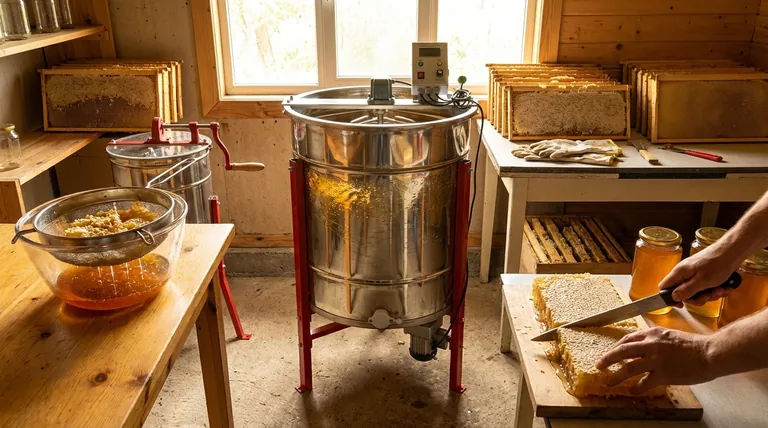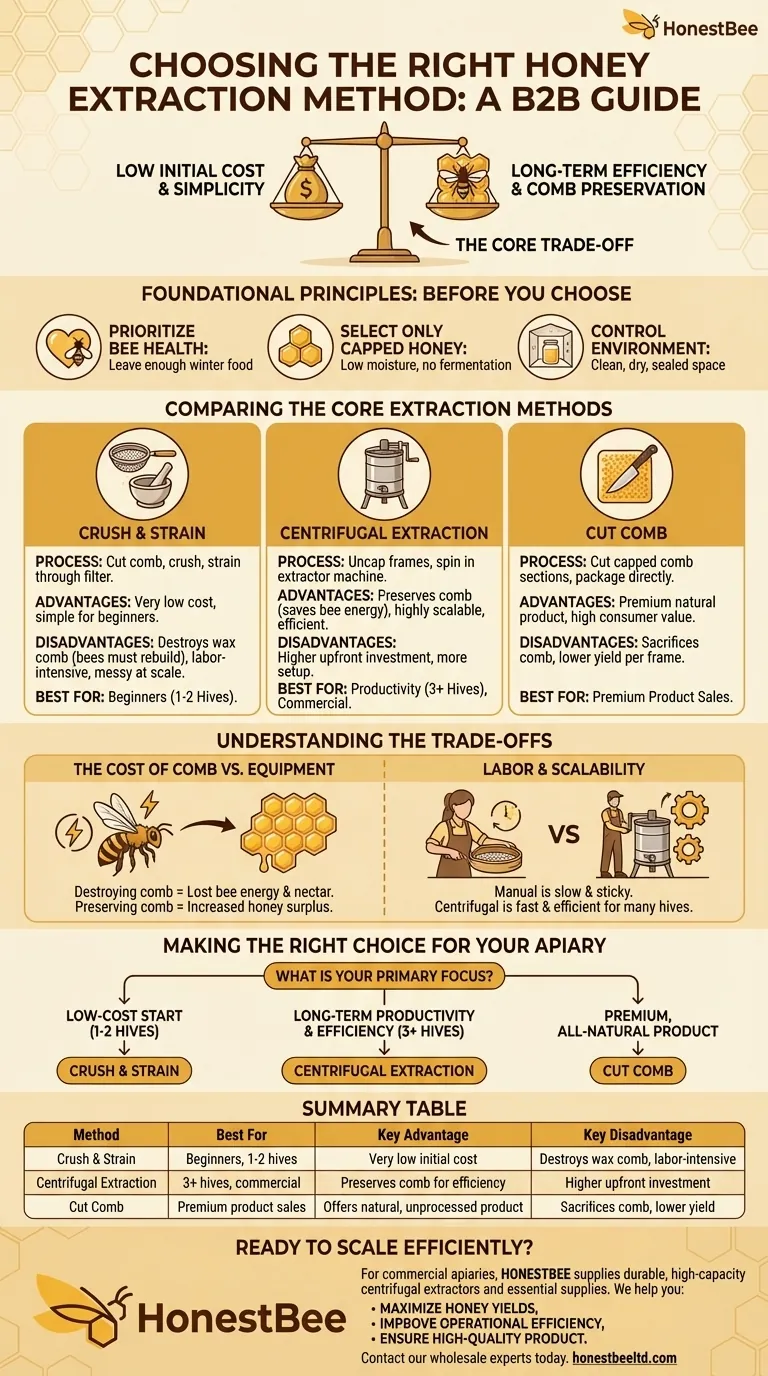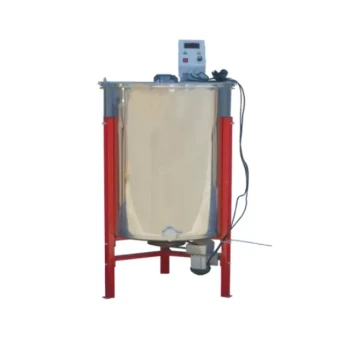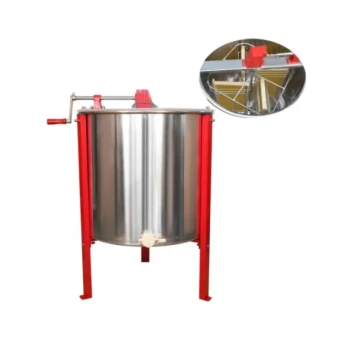Choosing the right honey extraction method is a critical decision for any beekeeper. Your choice depends on the size of your apiary, your budget for equipment, and, most importantly, whether you want to preserve the delicate wax honeycomb for your bees to reuse. Each approach has distinct implications for your bees' energy, your labor, and your final product.
The core decision in honey extraction is a trade-off. You must weigh the low initial cost and simplicity of the crush and strain method against the long-term efficiency and bee-friendly benefits of investing in a centrifugal extractor that preserves the comb.

Foundational Principles: Before You Choose
Regardless of the method you select, certain principles are non-negotiable for ensuring a high-quality harvest and a healthy hive.
Prioritize Bee Health First
Before taking any honey, assess your colony's needs. A hive in its first year should be left with all its honey to ensure it has enough resources to survive its first winter.
Even for established hives, you must always leave a substantial amount of honey behind. This is their essential food source for the cold months.
Select Only Capped Honey
Only harvest frames where the honeycomb cells are fully sealed with a wax cap. This capped honey has the correct low moisture content (around 18%) that prevents fermentation and spoilage from yeasts.
Uncapped nectar contains too much water. Including it can ruin your entire batch of honey.
Control Your Extraction Environment
Your extraction space must be clean, dry, and completely sealed off from bees. The scent of honey can travel far, attracting your own bees and others, which can lead to agitation and robbing behavior.
A warm room (and warm honey) allows the honey to flow much more freely, which is ideal for spinning or straining. Conversely, a cooler room is better for the "cut comb" method, as it keeps the wax firm and less prone to damage.
Comparing the Core Extraction Methods
There are three primary ways to get honey from the comb, each with its own process and outcomes.
Method 1: Crush and Strain
This is the oldest and most straightforward method. The honeycomb is cut from the frames, crushed by hand or with a tool, and the resulting mixture of honey and wax is poured through a sieve or filter to separate them.
It requires minimal specialized equipment, making it a very low-cost entry point for beginners.
Method 2: Centrifugal Extraction
This method uses a machine called an extractor to spin frames at high speed. First, the wax cappings are sliced off the comb with a special knife. The frames are then placed in the extractor, and centrifugal force flings the honey out of the cells onto the extractor walls, where it drips to the bottom.
The key advantage is that it preserves the empty honeycomb, which can be returned to the hive.
Method 3: Cut Comb
This isn't just an extraction method; it's a way of preparing a specific product. Instead of removing the honey, you simply cut sections of the fully capped honeycomb out of the frame and package them as is.
This offers a premium, natural product that many consumers value, but it sacrifices the comb just like the crush and strain method.
Understanding the Trade-offs
Choosing a method requires you to balance cost, efficiency, and the impact on your bees.
The Cost of Equipment vs. The Cost of Comb
The crush and strain method is cheap upfront, but it has a hidden "cost" for the bees. Bees expend a tremendous amount of energy and consume significant nectar to produce wax and draw out comb. Destroying it forces them to restart this work every season.
A centrifugal extractor is a significant investment, but by preserving the comb, you save your bees that energy. This allows them to focus on gathering more nectar, which can lead to a larger honey surplus in subsequent years.
Labor and Scalability
Crush and strain is simple for one or two hives but quickly becomes a sticky, time-consuming mess at a larger scale. The process is manually intensive and inefficient.
Centrifugal extraction involves more setup and cleaning but is far more scalable. It allows you to process many frames and hives with much greater speed and less mess once you get started.
Honey Quality Considerations
Both methods can yield excellent honey if done correctly by starting with capped frames and maintaining a clean environment.
However, the crush and strain method introduces many more fine wax particles into the honey, requiring more thorough filtering to achieve a clear final product.
Making the Right Choice for Your Apiary
Your goal determines your best path forward.
- If your primary focus is a low-cost start with 1-2 hives: The crush and strain method is a perfectly acceptable way to begin your beekeeping journey.
- If your primary focus is long-term hive productivity and efficiency (3+ hives): Investing in a centrifugal extractor is the clear choice for preserving comb and maximizing your potential honey harvest.
- If your primary focus is creating a premium, all-natural product: The cut comb method allows you to package and sell honey in its most raw and unprocessed form.
Ultimately, the best method is the one that aligns with your scale, your budget, and your philosophy of beekeeping.
Summary Table:
| Method | Best For | Key Advantage | Key Disadvantage |
|---|---|---|---|
| Crush & Strain | Beginners, 1-2 hives | Very low initial cost | Destroys wax comb, labor-intensive to scale |
| Centrifugal Extraction | 3+ hives, commercial apiaries | Preserves comb for bee efficiency | Higher upfront equipment investment |
| Cut Comb | Premium product sales | Offers a natural, unprocessed product | Sacrifices comb, lower yield per frame |
Ready to scale your honey production efficiently?
For commercial apiaries and beekeeping equipment distributors, choosing the right extraction equipment is critical for long-term profitability and hive health. HONESTBEE supplies durable, high-capacity centrifugal extractors and other essential beekeeping supplies designed for wholesale operations.
We help you:
- Maximize honey yields by preserving comb and saving your bees' energy.
- Improve operational efficiency with equipment built for scale.
- Ensure a high-quality product with reliable, professional-grade tools.
Contact our wholesale experts today to discuss the best extraction solutions for your business.
Visual Guide

Related Products
- Professional 4 Frame Self Reversing Electric Honey Extractor for Beekeeping
- Commercial Electric 12 Frame Honey Extractor Spinner Motorized Honey Extractor
- Electric 8 Frame Honey Spinner Extractor Equipment for Beekeeping
- HONESTBEE 72 Frame Industrial Electric Honey Extractor for Beekeeping
- 2 Frame Stainless Steel Manual Honey Spinner Extractor for Beekeeping
People Also Ask
- Why is it important to dry a honey extractor before storage? Prevent Mold, Protect Bees, & Extend Equipment Life
- Why is preserving honeycomb integrity important, and how do automated extractors help? Boost Hive Health & Honey Yields
- Can a manual extractor be upgraded to an electric one? Save Labor & Boost Efficiency
- Does honey need to be heated before extraction? The Right Way to Warm Honey for Easy Flow
- What should be done with wet frames after honey extraction? A Guide to Efficient Apiary Management



















